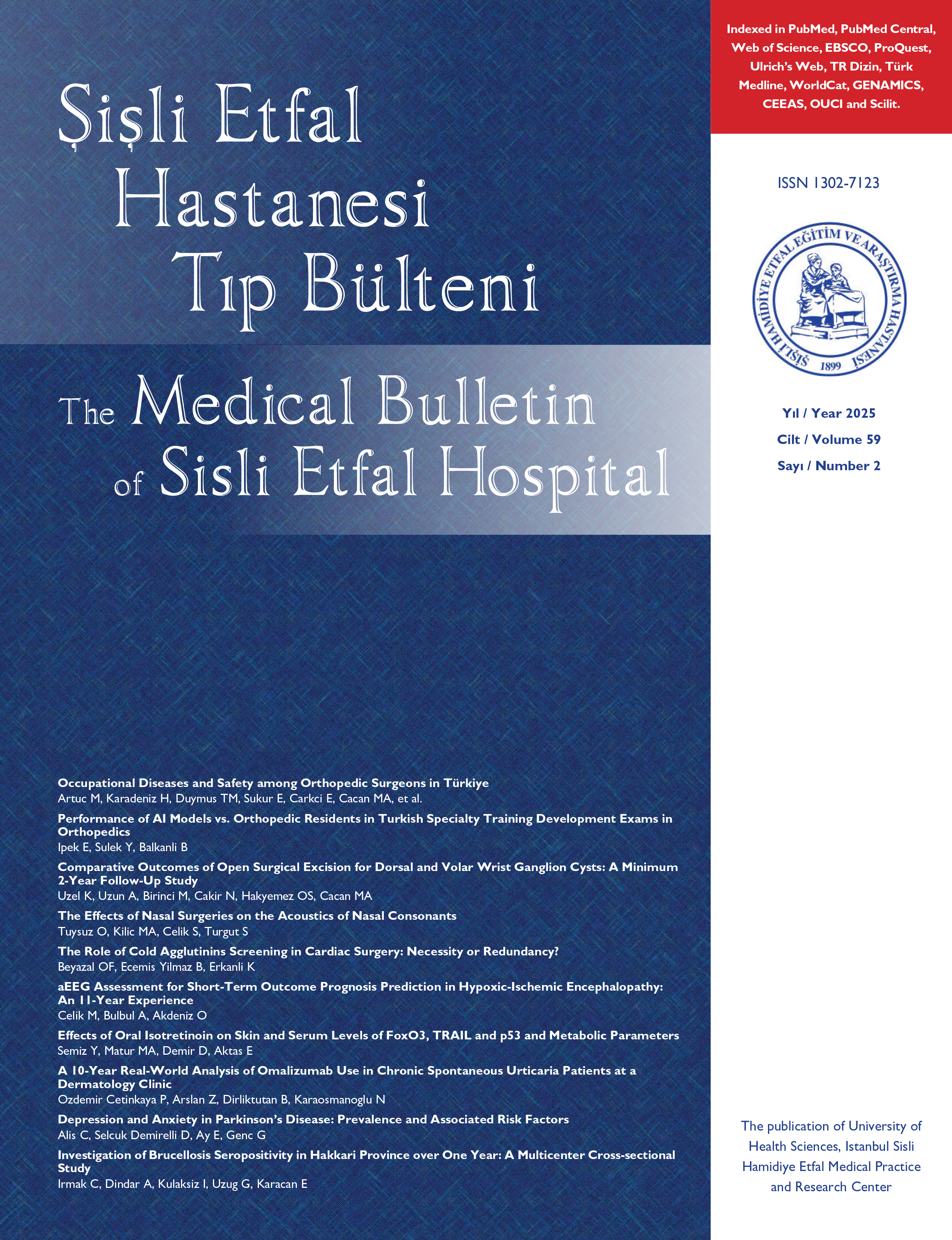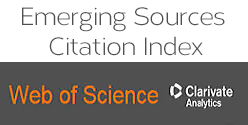
Farklı Tip Hiperfenilalaninemili 342 Hastada Gelişimsel ve Bilişsel Sonuçlar
Sibel Oz1, Halise Neslihan Onenli Mungan, Deniz Kor, Fatma Derya Bulut, Berna Seker Yilmaz, Sebile Kilavuz, Gulsah Seydaoglu1Çukurova Üniversitesi Tıp Fakültesi Pediatri Anabilim Dalı, Adana, Türkiye2Çukurova Üniversitesi Tıp Fakültesi Pediatri Metabolizma Anabilim Dalı, Adana, Türkiye
3Genetik ve Genomik Tıp, Great Ormond Street Çocuk Sağlığı Enstitüsü, University College London, Londra, Birleşik Krallık
4Marmara Üniversitesi Pediatri Metabolizma Anabilim Dalı, İstanbul, Türkiye
5Çukurova Üniversitesi Tıp Fakültesi Biyoistatistik Anabilim Dalı, Adana, Türkiye
Amaç: Bu çalışmanın amacı, farklı tip hiperfenilalaninemi (HFA) tanılı hastalarda nörogelişimsel ve bilişsel sonuçları değerlendirmek, bu sonuçları etkileyen faktörleri belirlemek ve plazma fenilalanin (FA) düzeyine dayalı diyet tedavisi başlama eşiğiyle ilgili tartışmalara katkı sağlamaktır.
Yöntem: 1984-2018 yılları arasında Çocuk Sağlığı ve Hastalıkları Anabilim Dalı, Çocuk Metabolizma ve Beslenme Bilim Dalı'nda izlenen ve gelişimsel/bilişsel değerlendirmesi yapılmış HFA hastaları retrospektif olarak incelendi. Çalışmaya diyet ve/veya tetrahidrobiopterin (BH4) ile tedavi edilen Hafif (FA: 360-600 μmol/L), orta (FA: 600-1200 μmol/L), klasik fenilketonüri (FKÜ) (FA≥1200 μmol/L) ve tedavisiz takip edilen HFA hastaları (FA: 240-360 μmol/L) dahil edildi. Bu sınıflandırma, tanı anında ölçülen plazma FA düzeylerine göre yapılmıştır. Gelişimsel ve bilişsel değerlendirme için Denver Gelişimsel Tarama Testi (DGTT), Stanford-Binet testi ve Türk çocuklarına uyarlanmış Wechsler Zeka Ölçeği (WISC-R) uygulanmıştır. Zeka katsayısı (IQ) Stanford-Binet veya WISC-R testlerinde <70 olan çocuklar ya da DGTTde iki veya daha fazla gelişim alanında gecikme saptananlar, zihinsel yetersizlik veya gelişimsel gecikme (ZY/GG) olarak sınıflandırılmıştır. ZY/GG ile tanı yaşı, tanı yöntemi, plazma FA seviyeleri ve beyin MRG bulguları arasındaki ilişkiler analiz edilmiştir.
Bulgular: Çalışmaya 182si (%53.2) kız ve 160ı (%46.8) erkek olmak üzere toplam 342 hasta dahil edildi. Bu hastaların 53ü (%15.5) hafif FKÜ, 97si (%28.4) orta FKÜ, 102si (%29.8) klasik FKÜ ve 90ı (%26.3) HFA tanılıydı. Diyet ve/veya BH4 ile tedavi edilen hastalarda ZY/GG ile hem tanı yaşı hem de tanı yöntemi arasında anlamlı ilişki bulundu (sırasıyla, p<0.001, p<0.01). ZY/GG olan hastalarda, takipteki birinci, üçüncü ve son yıl ortalama plazma Phe düzeyleri, normal bilişsel/gelişimsel sonucu olan hastalara göre anlamlı düzeyde daha yüksekti (p<0.024). Beyin MRG'de saptanan beyaz cevher anormallikleri; FKÜ şiddeti, ZY/GG varlığı ve son yıl ortanca FA düzeyleri ile anlamlı ilişki gösterdi (sırasıyla, p=0.01, p<0.001, p<0.001). Dikkat çeken bir bulgu olarak, düzenli izlem ve bilinen risk faktörlerinin yokluğuna rağmen tedavisiz izlenen HFA hastalarının 9unda (%10) ZY/GG saptanmıştır.
Sonuç: Erken tanı ve tedaviye ek olarak, yaşam boyu tedaviye uyum ve düzenli izlem, FKÜlü bireylerde normal nörogelişimsel ve bilişsel sonuçlar açısından kritiktir. Klinik yönetim merkezler arasında farklılık göstermektedir. Tedavisiz izlenen HFA hastalarının %10unda gelişimsel gerilik saptanması, plazma FA düzeyine göre tedavi başlama eşiklerinin yeniden değerlendirilmesi gerekliliğine dikkat çekmektedir.
Developmental and Cognitive Outcomes in 342 Patients With Different Types of Hyperphenylalaninemia
Sibel Oz1, Halise Neslihan Onenli Mungan, Deniz Kor, Fatma Derya Bulut, Berna Seker Yilmaz, Sebile Kilavuz, Gulsah Seydaoglu1Department of Pediatrics, Cukurova University Medical Faculty, Adana, Türkiye2Department of Pediatrics Metabolism, Cukurova University Medical Faculty, Adana, Türkiye
3Genetics and Genomic Medicine, Great Ormond Street Institute of Child Health, University College London, London, UK
4Department of Pediatrics Metabolism, Marmara University, Istanbul, Türkiye
5Department of Biostatistics, Cukurova University Medical Faculty, Adana, Türkiye
Objectives: The aim of this study is to evaluate neurodevelopmental and cognitive outcomes in patients diagnosed with different types of hyperphenylalaninemia (HPA), identify the factors influencing these outcomes, and contribute to the debate regarding the thresold for initiating dietary treatment based on plasma phenylalanine (Phe) levels.
Methods: Patients with hyperphenylalaninemia (HPA) who were followed up and had developmental and/or cognitive evaluations at the Division of Pediatric Metabolism and Nutrition, Department of Pediatrics, between 1984 and 2018, were retrospectively assessed. The study included patients with mild (Phe: 360-600 μmol/L), moderate (Phe: 600-1200 μmol/L), or classic Phenylketonuria (PKU) (Phe ≥1200 μmol/L) treated with diet and/or tetrahydrobiopterin (BH4), along with untreated HPA patients (Phe: 240-360 μmol/L). This classification was based on plasma Phe levels measured at the time of diagnosis. Denver Developmental Screening Test (DDST), Stanford-Binet test, and Wechsler Intelligence Scale for Children (WISC-R) adapted for Turkish children were applied for developmental and cognitive evaluation. Intellectual disability or developmental delay (ID/DD) was defined as a full-scale intelligence quotient (IQ) <70 on the Stanford-Binet or WISC-R, or as delay in two or more developmental domains on the DDST, with children meeting any of these criteria classified as having ID/DD. The relationships between ID/DD, age at diagnosis, diagnostic methods, plasma Phe levels, and brain MRI findings were analyzed.
Results: A total of 342 patients were included in the study, comprising 182 (53.2%) females and 160 (46.8%) males. Of these, 53 (15.5%) had mild PKU, 97 (28.4%) had moderate PKU, 102 (29.8%) had classic PKU, and 90 (26.3%) were diagnosed with HPA. A significant association was found between ID/DD and both the age at diagnosis and diagnostic method in patients treated with diet and/or BH4 (p < 0.001 and p < 0.01, respectively). In patients with ID/DD, the median plasma Phe levels at the first, third, and last years of follow-up were significantly higher compared to patients without ID/DD (p < 0.024). White matter abnormalities observed on brain MRI were significantly associated with PKU severity, the presence of ID/DD, and the median plasma Phe levels in the last year of follow-up (p = 0.01, p < 0.001, and p < 0.001, respectively). Notably, 9 (10% ) of untreated HPA patients exhibited ID/DD, despite regular follow-up and the absence of known risk factors.
Conclusion: In addition to early diagnosis and treatment, lifelong adherence and regular follow-up are essential for achieving normal neurodevelopmental and cognitive outcomes in individuals with PKU. However, clinical management remains heterogeneous across centers. The presence of developmental delay in 10% of untreated HPA patients underscores the need to urgently re-evaluate current plasma Phe thresholds for treatment initiation and follow-up. (SETB-2025-12-209)
Makale Dili: İngilizce



















